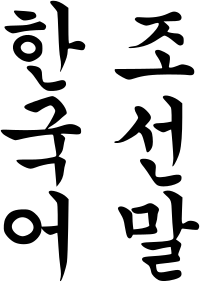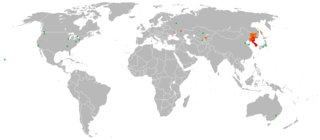
Back Акореиа бызшәа Abkhazian Koreaans Afrikaans Koreanische Sprache ALS ኮሪይኛ Amharic Idioma coreano AN कोरियाई भाषा ANP اللغة الكورية Arabic لغه كورى ARZ কোৰীয় ভাষা Assamese Idioma coreanu AST
| Wikang Koreano | |
|---|---|
| 한국어, 조선말 Hangugeo, Chosŏnmal | |
 | |
| Katutubo sa | Timog Korea, Hilagang Korea, People's Republic of China, Estados Unidos |
Mga natibong tagapagsalita | 78 milyon (1999 est.)[1] |
| Hangul (Both Koreas), mix of Hangul and hanja (some professional scripts in S. Korea), or Cyrillic alphabet (lesser used in Goryeomal) | |
| Opisyal na katayuan | |
Yanbian ( | |
| Pinapamahalaan ng | South Korea: The National Institute of the Korean Language 국립국어원 North Korea: Sahoe Kwahagwon Ŏhak Yŏnguso 사회과학원 어학연구소 |
| Mga kodigong pangwika | |
| ISO 639-1 | ko |
| ISO 639-2 | kor |
| ISO 639-3 | kor |
| Linguasphere | 45-AAA-a |
 Countries with native Korean-speaking populations | |
Ang Wikang Koreano (Timog Korea: 한국어 hangugeo, Hilagang Korea: 조선말 chosŏnmal) ay ang opisyal na wika ng parehong Hilagang Korea at Timog Korea. Ito rin ang isa sa dalawang opisyal na wika sa Nagsasariling Prepekturang Koreano ng Yanbian sa Tsina. Isinusulat ito sa alpabetong Hangeul. Mahigit sa 78 milyong katao ang nagsasalita ng Wikang Koreano sa buong daigdig. Sa mahigit na sanlibong taon, ang Wikang Koreano ay isinusulat kasama ng mga hiram na karakter panulat ng mga Tsino at tinawag na hanja, kasama ang mga sistemang ponetikong gaya ng hyangchal, gugyeol, at idu. Noong ika-15 dantaon, isang pambansang sistemang panulat ang tinawag na hangul ang pinagawa ni Sejong na Dakila, subali't hindî agad nagamit ng lahat hanggang noon lamang ika-20 dantaon, dahil sa higit na pinili ng aristokrasyang yangban noon ang paggamit ng hanja.
Ang kaurian ng angkan ng Wikang Koreano ay pinagtatalunan ng maraming mga linguistiko. Marami ang nag-uuri dito bilang hiwalay na wika[8] samantalang may mga nagsasabi na kabilang ito sa kontrobersiyal na pamilyang wika ng Altaic.[9] Isang aglunatibong wika ang wikang Koreano sa kanyang morpolohiya at ang kanyang syntax ay simuno-paksa-pandiwa.
- ↑ "Korean". Ethnologue, 14th ed. Nakuha noong 2008-09-25.
{{cite web}}: CS1 maint: date auto-translated (link) - ↑ Song, Jae Jung (2005), The Korean language: structure, use and context, Routledge, p. 15, ISBN 978-0-415-32802-9
{{citation}}: CS1 maint: date auto-translated (link). - ↑ Campbell, Lyle; Mixco, Mauricio (2007), "Korean, A language isolate", A Glossary of Historical Linguistics, University of Utah Press, pp. 7, 90–91,
most specialists... no longer believe that the... Altaic groups... are related […] Korean is often said to belong with the Altaic hypothesis, often also with Japanese, though this is not widely supported
{{citation}}: CS1 maint: date auto-translated (link). - ↑ Dalby, David (1999 – 2000), The Register of the World's Languages and Speech Communities, Linguasphere Press
{{citation}}: Check date values in:|year=(tulong). - ↑ Kim, Nam-Kil (1992), "Korean", International Encyclopedia of Linguistics, bol. 2, pp. 282–86,
scholars have tried to establish genetic relationships between Korean and other languages and major language families, but with little success
{{citation}}: CS1 maint: date auto-translated (link). - ↑ Róna-Tas, András (1998), "The Reconstruction of Proto-Turkic and the Genetic Question", The Turkic Languages, Routledge, pp. 67–80,
[Ramstedt's comparisons of Korean and Altaic] have been heavily criticised in more recent studies, though the idea of a genetic relationship has not been totally abandoned
{{citation}}: CS1 maint: date auto-translated (link). - ↑ Schönig, Claus (2003), "Turko-Mongolic Relations", The Mongolic Languages, Routledge, pp. 403–19,
the 'Altaic' languages do not seem to share a common basic vocabulary of the type normally present in cases of genetic relationship
{{citation}}: CS1 maint: date auto-translated (link). - ↑ Song, Jae Jung (2005) "The Korean language: structure, use and context" Routledge, p. 15
Lyle Campbell & Mauricio Mixco. 2007. A Glossary of Historical Linguistics. University of Utah Press. ("Korean, A language isolate", pg. 90; "Korean is often said to belong with the Altaic hypothesis, often also with Japanese, though this is not widely supported," pp. 90-91; "...most specialists...no longer believe that the...Altaic groups...are related," pg. 7)
David Dalby. 1999/2000. The Linguasphere Register of the World's Languages and Speech Communities. Linguasphere Press.
Nam-Kil Kim. 1992. "Korean," International Encyclopedia of Linguistics. Volume 2, pp. 282-286. ("...scholars have tried to establish genetic relationships between Korean and other languages and major language families, but with little success," pg. 282)
András Róna-Tas. 1998. "The Reconstruction of Proto-Turkic and the Genetic Question," The Turkic Languages. Routledge. Pp. 67-80. ("[Ramstedt's comparisons of Korean and Altaic] have been heavily criticised in more recent studies, though the idea of a genetic relationship has not been totally abandoned," pg. 77.)
Claus Schönig. 2003. "Turko-Mongolic Relations," The Mongolic Languages. Routledge. Pp. 403-419. ("...the 'Altaic' languages do not seem to share a common basic vocabulary of the type normally present in cases of genetic relationship," pg. 403) - ↑ Stratification in the peopling of China: how far does the linguistic evidence match genetics and archaeology? In; Sanchez-Mazas, Blench, Ross, Lin & Pejros eds. Human migrations in continental East Asia and Taiwan: genetic, linguistic and archaeological evidence. 2008. Taylor & Francis
© MMXXIII Rich X Search. We shall prevail. All rights reserved. Rich X Search